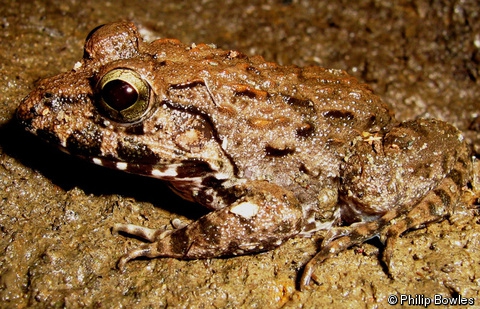| Taxon ID: 22,451 Total records: 39,143 | ||||||||||||||
Fejervarya cancrivora
Country
| Country | Singapore |
|---|---|
| Continent Ocean | Asia |
Classification
| Kingdom | Animalia (COL) |
|---|---|
| Phylum | Chordata (COL) |
| Class | Amphibia (COL) |
| Order | Anura (COL) |
| Family | Dicroglossidae (COL) |
Taxonomy
| Genus | Fejervarya | Reference | |
|---|---|---|---|
| SubGenus | Vernacular Name | ||
| Species | cancrivora | IUCN Threat Status-Year | Least Concern, 2004 |
| SubSpecies | Nat'l Threat Status-Year | Not Evaluated, 2000 | |
| Infraspecies | Reason for Change | ||
| Infraspecies Rank | CITES | ||
| Taxonomic Group | Amphibians | Native Status | Native |
| Scientific Name Author | Gravenhorst, 1829 | Country Distribution | Singapore |
| Citation | Description | Geographic Range [top]
Range Description: This is a widely distributed frog. It is known from coastal southern China in Guangxi and Hainan Provinces, from Great Nicobar Island in India, and from most countries in Southeast Asia including the Philippines. In New Guinea introduced populations are known from the Sorong, Manokwari, Nabire and Jayapura areas of Papua, Indonesia. It has been introduced to Guam, although its breeding status and range in this island are unclear (Christy et al. 2007).
Countries occurrence:
Native:
Brunei Darussalam; Cambodia; China; India; Indonesia (Papua - Introduced); Lao Peoples Democratic Republic; Malaysia; Philippines; Singapore; Thailand; Viet Nam
Introduced:
Guam
Additional data:
Range Map: Click here to open the map viewer and explore range.
Population [top]
Population: It is common to abundant in appropriate habitats. It is introduced to New Guinea and its population there is increasing.
Current Population Trend: Increasing
Additional data:
? Population severely fragmented: No
Habitat and Ecology [top]
Habitat and Ecology: It occurs in mangrove forest, estuarine habitats, swamps and open, wet coastal areas, such as roadside ditches and puddles. It also thrives in man-made environments such as rice paddy fields. Tadpoles develop in rain pools above the high water line on the mainland, and in any body of standing water in the Philippines. It is tolerant of moderate salinity.
Systems: Terrestrial; Freshwater
Use and Trade [top]
Use and Trade: This species is harvested for human consumption.
Threats [top]
Major Threat(s): Over-harvesting is a potential threat to this species. Habitat destruction and degradation might also be threatening some populations, in particular the destruction of mangroves for wood, expansion of human settlements, and the construction of roads. There are no threats to the species in the Nicobar Islands. In New Guinea this species is probably a threat to native fauna.
Conservation Actions [top]
Conservation Actions: The range of this species includes a number of protected areas. Monitoring of populations and harvest levels in countries where it is exploited is needed. This species needs to be eradicated from New Guinea, and its breeding status in Guam needs to be determined. It is protected by national legislation in India.
Citation: Yuan Zhigang, Zhao Ermi, Shi Haitao, Diesmos, A., Alcala, A., Brown, R., Afuang, L., Gee, G., Sukumaran, J., Yaakob, N., Leong Tzi Ming, Yodchaiy Chuaynkern, Kumthorn Thirakhupt, Das, I., Iskandar, D., Mumpuni & Robert Inger. 2004. Fejervarya cancrivora. The IUCN Red List of Threatened Species 2004: e.T58269A11759436. http://dx.doi.org/10.2305/IUCN.UK.2004.RLTS.T58269A11759436.en. Downloaded on 20 April 2017.
Disclaimer: To make use of this information, please check the |
|
| Source |
Record Level
Growth Parameters
| Temperature | 0 | Observed Weight | 0 |
|---|---|---|---|
| Sex | Previous Catalog Number | ||
| Life Stage | Relationship Type | ||
| Preparation Type | Related Catalog Item | ||
| Individual Count | 0 | GML Features | |
| Observerd Individual Count | 0 | Notes |
Collecting Event
Images
|
Additional Info
Synonyms To Manage Synonyms for Fejervarya cancrivora, click this link: Synonyms. |
Rana cancrivora Gravenhorst, 1829 |
Common Names To Manage Common Names for Fejervarya cancrivora, click this link: Common Names. |
Asian Brackish Frog () ¦ Crab-eating Frog () ¦ |
Localities To Manage Localities for Fejervarya cancrivora, click this link: Localities. |
Species Record Details Encoded By:
Carlos Aurelio Callangan
|
Species Record Updated By:
Carlos Aurelio Callangan
|


